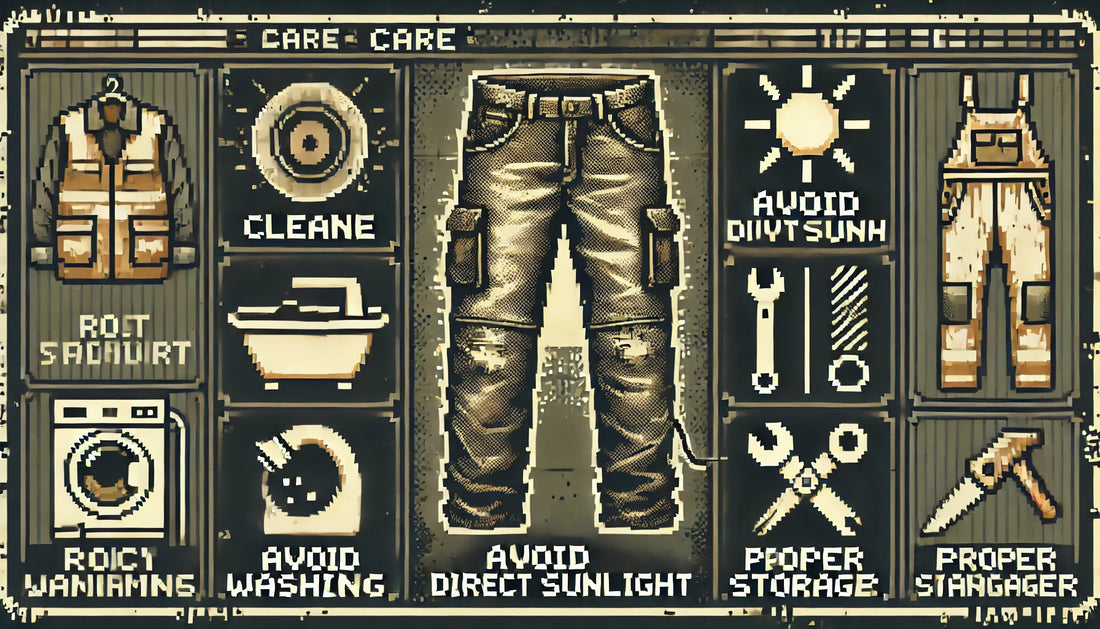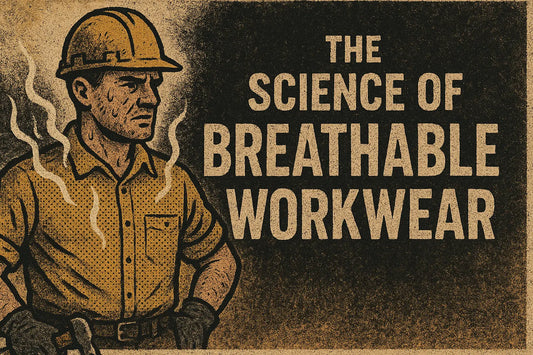
How Do I Care for and Maintain My Workwear Trousers to Extend Their Lifespan?
When you’re out on site, your workwear trousers take a beating. Whether you’re climbing ladders, kneeling on rough surfaces, or exposed to the elements, these trousers are built to withstand tough conditions. However, even the most durable workwear needs proper care and maintenance to keep them in top condition. In this comprehensive guide, we’ll explore practical tips and tricks to help you extend the lifespan of your workwear trousers, ensuring they remain as effective and comfortable as the day you bought them.
1. Choosing the Right Trousers for Longevity
Key Point: The first step in maintaining your workwear trousers is selecting the right pair in the first place.
Before diving into care and maintenance, it’s crucial to understand that the longevity of your workwear trousers starts with the purchase. Investing in high-quality trousers made from durable materials will save you time and money in the long run. Look for trousers that feature reinforced knees, triple-stitched seams, and high-resistance fabrics such as Cordura or ripstop. These materials are specifically designed to handle the demands of tough work environments.
According to the British Standards Institution (BSI), workwear that adheres to strict quality standards often outlasts cheaper alternatives, reducing the need for frequent replacements.
Pro Tip: Visit Tauro Workwear for a range of high-quality workwear trousers designed to last, including options with built-in knee pads and multiple pocket configurations.
2. Regular Cleaning: A Must for Durability
Key Point: Regular cleaning not only keeps your trousers looking good but also removes dirt and debris that can degrade the fabric over time.
Dirt, grease, and grime are all part of the job, but they can take a toll on your workwear trousers if left untreated. Regular cleaning is essential to prevent the buildup of these substances, which can weaken the fabric and lead to premature wear and tear. However, it’s important to clean your trousers correctly to avoid damaging the material.
- Machine Wash with Care: Always follow the washing instructions on the label. Most workwear trousers can be machine washed, but using a gentle cycle and cold water can help preserve the fabric. Hot water can cause certain materials to shrink or lose their protective coatings.
- Avoid Harsh Detergents: Use a mild detergent that’s free from bleach or strong chemicals, as these can break down the fibres in your trousers. Eco-friendly detergents are a great choice for both your clothes and the environment.
- Turn Inside Out: Washing your trousers inside out can help protect the outer surface from fading and wear, especially if they have high-visibility or reflective elements.
A study from the University of Southampton found that frequent washing with harsh detergents significantly reduces the lifespan of workwear, highlighting the importance of proper cleaning practices.
Pro Tip: Pre-treat stains with a fabric-safe stain remover before washing to ensure that stubborn marks don’t set in.
3. Drying Techniques: Avoiding Damage
Key Point: The way you dry your workwear trousers is just as important as how you wash them.
After washing, how you dry your trousers can greatly impact their longevity. Improper drying techniques can cause shrinking, fading, and even damage to protective coatings.
- Air Dry When Possible: The safest way to dry workwear trousers is to hang them up and allow them to air dry. This method prevents shrinking and reduces wear on the fabric.
- Avoid Direct Sunlight: While air drying is best, avoid leaving your trousers in direct sunlight for extended periods. UV rays can fade colours and weaken the fabric over time.
- Tumble Dry with Caution: If you need to use a tumble dryer, select a low-heat setting. High heat can shrink the fabric and damage any water-resistant or flame-retardant treatments.
The Health and Safety Executive (HSE) advises that prolonged exposure to high heat can compromise the protective features of certain types of workwear, such as flame-resistant trousers.
Pro Tip: Use a drying rack indoors to avoid potential sun damage and maintain the integrity of your workwear.
4. Storage Solutions: Protecting Your Investment
Key Point: Proper storage can prevent unnecessary wear and extend the lifespan of your workwear trousers.
How you store your workwear trousers when not in use can also influence their durability. Storing them improperly can lead to wrinkles, creases, and even fabric damage.
- Hang, Don’t Fold: Hanging your trousers in a well-ventilated closet helps maintain their shape and reduces the risk of wrinkles and creases. Use sturdy hangers that can support the weight of heavy-duty trousers.
- Keep Away from Damp: Store your trousers in a dry area. Damp environments can lead to mould and mildew, which can ruin the fabric and create unpleasant odours.
- Rotate Your Trousers: If you have multiple pairs of workwear trousers, rotating them regularly can reduce the wear on any single pair, effectively extending their lifespan.
A report from the University of Leeds highlights that proper storage conditions are crucial for maintaining the quality and performance of workwear over time.
Pro Tip: Invest in a few extra pairs of trousers to rotate them throughout the week, giving each pair time to recover and reducing overall wear.
5. Repair and Reinforcement: Prolonging Wear
Key Point: Timely repairs can prevent minor issues from turning into major problems.
Even the best workwear trousers will experience some wear and tear over time. Instead of discarding them at the first sign of damage, consider repairing them. Simple fixes can extend the life of your trousers by months or even years.
- Patch Holes and Tears: For small holes or tears, use a patch kit to reinforce the damaged area. Many workwear brands offer patch kits specifically designed for their products.
- Reinforce High-Wear Areas: If certain areas of your trousers (like the knees or pockets) are showing signs of wear, consider reinforcing them with extra fabric or patches before they fully give out.
- Replace Worn-Out Zippers and Buttons: Don’t let a broken zipper or missing button render your trousers useless. Most tailors can easily replace these components, giving your trousers a new lease on life.
The British Textile Technology Group (BTTG) recommends regular inspections of workwear for signs of wear and tear, with prompt repairs to avoid further damage.
Pro Tip: Keep a basic sewing kit on hand or find a local tailor who can make quick repairs when needed.
6. Understanding Fabric Treatments and Coatings
Key Point: Many workwear trousers come with special fabric treatments that require specific care to maintain.
Modern workwear trousers often come with various fabric treatments, such as water resistance, stain resistance, or flame retardancy. Understanding these treatments and how to care for them is key to maintaining their effectiveness.
- Water-Resistant Coatings: Trousers with water-resistant coatings should be washed with care, as harsh detergents can strip the coating over time. Look for detergents designed for outdoor gear to maintain the water resistance.
- Flame-Retardant Fabrics: Flame-retardant trousers should be cleaned according to the manufacturer’s instructions, as improper washing can reduce their protective properties. Avoid using bleach or fabric softeners.
- Reapply Treatments: Over time, fabric treatments can wear off. Some treatments, like water repellency, can be reapplied using specialised sprays or washes available at outdoor and workwear stores.
According to the National Physical Laboratory (NPL), reapplying protective coatings at regular intervals can help maintain the safety and performance of treated workwear.
Pro Tip: Always check the care label on your trousers for specific instructions regarding fabric treatments, and follow them closely to avoid compromising their protective features.
7. Avoiding Common Mistakes
Key Point: Simple mistakes can significantly shorten the lifespan of your workwear trousers.
Despite the best intentions, there are common mistakes that many tradesmen make when caring for their workwear trousers. Avoiding these can help you get the most out of your investment.
- Overloading the Washing Machine: Overloading your washing machine can cause unnecessary friction between garments, leading to pilling and fabric wear. Wash your workwear in smaller loads to ensure a thorough and gentle clean.
- Using Fabric Softeners: Fabric softeners can leave a residue on workwear, especially on water-resistant or flame-retardant fabrics. This residue can reduce the effectiveness of these treatments and attract more dirt.
- Ignoring Care Labels: The care labels on your workwear trousers provide vital information about how to wash, dry, and store them. Ignoring these instructions can lead to premature wear and tear.
A study by the University of Manchester found that improper washing and care practices were one of the leading causes of reduced lifespan in workwear garments.
Pro Tip: Take the time to read and follow the care instructions provided by the manufacturer to avoid these common pitfalls.
8. Professional Cleaning: Is It Worth It?
Key Point: Professional cleaning services can be a worthwhile investment for certain types of workwear trousers.
For workwear trousers that have been heavily soiled or are made from specialised materials, professional cleaning might be the best option. While it’s more expensive than home washing, professional services can provide a deeper clean without damaging the fabric.
- Dry Cleaning for Special Fabrics: Some trousers, especially those with complex fabric treatments, may benefit from dry cleaning. Dry cleaners can handle delicate fabrics and treatments that regular washing machines cannot.
- Industrial Cleaning Services: For tradesmen in particularly dirty or hazardous environments, industrial cleaning services offer a thorough clean that removes even the toughest stains and contaminants.
The Textile Services Association (TSA) notes that professional cleaning can extend the life of workwear, particularly for garments exposed to hazardous materials.
Pro Tip: Use professional cleaning sparingly, and ensure the service provider is experienced with workwear and the specific needs of your trousers.
9. Environmental Impact and Sustainable Practices
Key Point: Caring for your workwear trousers in a way that minimises environmental impact is important for both the planet and your wallet.
In today’s world, sustainability is more important than ever. How you care for your workwear trousers can have a significant impact on the environment.
- Eco-Friendly Detergents: Opt for detergents that are biodegradable and free from harsh chemicals. These are less likely to damage the fabric and are better for the environment.
- Cold Water Washing: Washing your clothes in cold water not only saves energy but also reduces the wear on the fabric, helping your trousers last longer.
- Reduce Water Usage: Be mindful of how much water you’re using during washing. Only wash your trousers when necessary, and avoid running half-empty loads.
According to research by the University of Cambridge, adopting more sustainable laundry practices can significantly reduce your carbon footprint while extending the life of your garments.
Pro Tip: Consider line drying your trousers outdoors to save energy and avoid the wear and tear that comes with machine drying.
10. Knowing When to Replace Your Workwear Trousers
Key Point: Even with the best care, there comes a time when workwear trousers need to be replaced.
No matter how well you care for your workwear trousers, they won’t last forever. Knowing when it’s time to replace them is key to maintaining safety and comfort on the job.
- Excessive Wear: If your trousers have multiple holes, worn-out knees, or fraying seams that can’t be repaired, it’s time for a new pair.
- Loss of Protective Features: If the water-resistant coating no longer works, or the flame-retardant properties have diminished, it’s crucial to replace the trousers to ensure your safety.
- Fit Issues: If your trousers no longer fit comfortably or restrict your movement, it’s time to upgrade to a new pair that better suits your current needs.
The British Safety Industry Federation (BSIF) advises that regular assessments of workwear should be conducted to ensure they continue to meet safety standards.
Pro Tip: When it’s time to replace your trousers, consider recycling the old ones or donating them to avoid unnecessary waste.
Conclusion
Caring for your workwear trousers doesn’t have to be a chore. By following these practical tips and avoiding common mistakes, you can significantly extend the lifespan of your trousers, ensuring they remain comfortable, functional, and safe for as long as possible. From proper washing and drying techniques to timely repairs and understanding fabric treatments, each step plays a vital role in maintaining the quality and performance of your workwear.
Remember, investing a little time in the care and maintenance of your workwear trousers can save you money in the long run and keep you looking and feeling professional on the job. For more information on selecting and caring for your workwear, visit Tauro Workwear, where you’ll find a range of high-quality options designed to withstand the demands of your trade.




